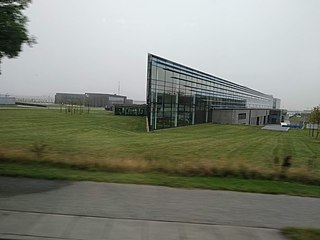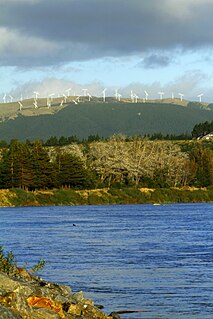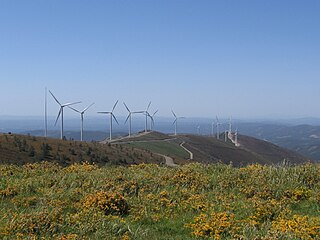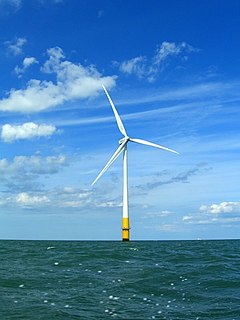
Te Apiti is a wind farm owned and operated by Meridian Energy. It is located on 11.5 km² of land north of the Manawatu Gorge in the North Island of New Zealand. At 90.75 MW, it was New Zealand's largest capacity wind farm until September 2007, when the third stage of the nearby Tararua Wind Farm was completed.

Vestas Wind Systems A/S is a Danish manufacturer, seller, installer, and servicer of wind turbines that was founded in 1945. The company operates manufacturing plants in Denmark, Germany, the Netherlands, Taiwan, India, Italy, Romania, the United Kingdom, Spain, Sweden, Norway, Australia, China, Brazil, Poland and the United States, and employs more than 25,000 people globally.

Te Rere Hau is a wind farm owned and operated by New Zealand Windfarms Ltd. It is situated on the Tararua Ranges, approximately 11 km east of Palmerston North in New Zealand.

Wind power is a major source of electricity in Portugal. At the end of 2020, wind power capacity in Continental Portugal was 5,456 MW. In 2020, wind power represented 23.7% of total electricity generation.

Wind power constitutes a small but growing proportion of New Zealand's electricity. As of December 2020, wind power accounts for 690 MW of installed capacity and over 5 percent of electricity generated in the country.
The electricity sector in New Zealand uses mainly renewable energy; such as hydropower, geothermal power and increasingly wind energy. As of 2019, 82% of electricity is generated from renewable sources, making New Zealand one of the countries with the lowest carbon dioxide emissions from electricity generation. Electricity demand grew by an average of 2.1% per year from 1974 to 2010 but decreased by 1.2% from 2010 to 2013.

The Kentish Flats Offshore Wind Farm is a wind farm located off the coast of Kent, England on a large, flat and shallow plateau just outside the main Thames shipping lanes. The wind farm is operated by Vattenfall.

The Waitahora Wind Farm was a proposed renewable energy project in New Zealand planned by Contact Energy but which has now been abandoned without construction beginning. This development was proposed to be located on the Puketoi Range which forms one side of the picturesque Waitahora Valley, near Dannevirke in Southern Hawke’s Bay.
Turitea Wind Farm is a 222-megawatt wind farm under construction near Turitea, Palmerston North, New Zealand. The farm is owned and operated by Mercury Energy.

The Mahinerangi Wind Farm is a wind farm on the north side of Lake Mahinerangi, around 50 km west of Dunedin, in Otago, New Zealand. Stage one of the wind farm, generating 36 MW, was commissioned in March 2011, and an additional 160 MW is consented to be commissioned in further stages.
Mill Creek Wind Farm is a wind farm in the Ohariu Valley near Wellington, New Zealand.
The Harapaki Wind Farm is a wind farm project in the Hawke's Bay region of New Zealand. Construction began in June 2021 and is expected to continue for three years.
As of June 2022, wind power in the Netherlands has an installed capacity of 8,052 MW, 30.5% of which is based offshore. In 2019, the wind turbines provided the country with 12% of its electricity demand during the year, a figure that is growing but somewhat below the average of 15% that wind power provides across the whole of the EU's electricity consumption. The Dutch are trying to meet the EU-set target of producing 14% of total energy use from renewable sources by 2020, and 16% by 2023. Windmills have historically played a major part in the Netherlands by providing an alternative to water driven mills.

Waterloo wind farm is east of Manoora, South Australia. It is the largest wind farm operated by EnergyAustralia.

Milton Keynes wind farm is located 2 miles east of Emberton in the Borough of Milton Keynes, Buckinghamshire, UK. It was developed by Your Energy and is owned by Mistral Windfarms. The wind farm comprises seven turbines 125 m to the blade tip, and has a total installed capacity of 14 MW. They were expected to produce approximately 38 GWh of electricity per year.
The Macarthur Wind Farm is a wind farm located in Macarthur, Victoria, Australia, near Hamilton, 260 km west of Melbourne. It is on a 5,500 ha site which has an installed capacity of 420 megawatts (MW). Based on a capacity factor of around 35%, it is estimated that the long-term average generation will be approximately 1,250 GWh per year. Its actual capacity factor is much lower, with a historical average of 26.29% since 2013.

Bangui Wind Farm is a wind farm in Bangui, Ilocos Norte, Philippines. The wind farm uses 20 units of 70-meter (230 ft) high Vestas V82 1.65 MW wind turbines, arranged in a single row stretching along a 9-kilometer (5.6 mi) shoreline off Bangui Bay, facing the West Philippine Sea.

The great majority of wind turbines around the world belong to individuals or corporations who use them to generate electric power or to perform mechanical work. As such, wind turbines are primarily designed to be working devices. However, the large size and height above surroundings of modern industrial wind turbines, combined with their moving rotors, often makes them among the most conspicuous objects in their areas. A few localities have exploited the attention-getting nature of wind turbines by placing them on public display, either with visitor centers on their bases, or with viewing areas farther away. The wind turbines themselves are generally of conventional horizontal-axis, three-bladed design, and generate power to feed electrical grids, but they also serve the unconventional roles of technology demonstration, public relations, and education.
The Waipipi Wind Farm is a wind powered electricity generation project in New Zealand owned and operated by Mercury NZ Ltd. This site is located between Patea and Waverley in South Taranaki. The wind farm consists of 31 wind turbines over 980 hectares, generating up to 133 MW at a cost of approximately $277 million. The 4.3 MW machines are the largest wind turbines installed in New Zealand.
Dundonnell Wind Farm is at Dundonnell, 23 kilometres (14 mi) northeast of Mortlake in the Australian state of Victoria. Construction began in January 2019 and was completed in 2020 with 80 Vestas wind turbines with a capacity to generate 336MW of electricity. The drive trains and hubs were assembled at the former Ford Australia site in Geelong.













